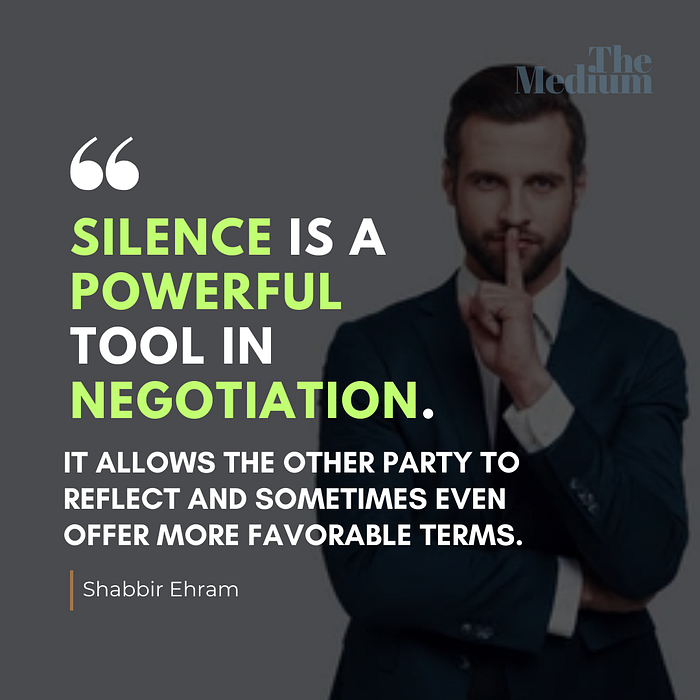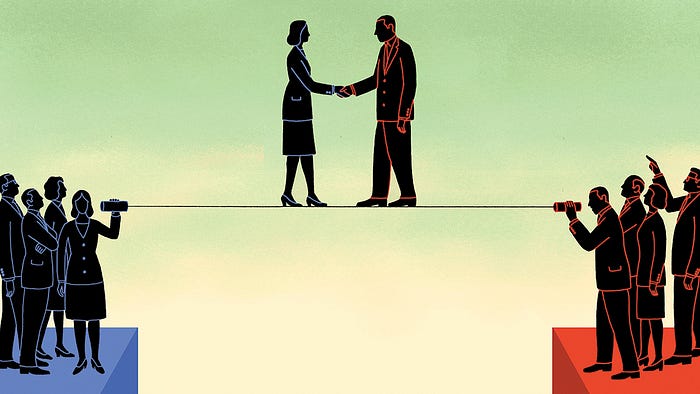Negotiate Like a Pro: Effective Communication Strategies for Winning Agreements
Negotiate Like a Pro: Effective Communication Strategies for Winning Agreements
by Shabbir Ehram | Corporate Trainer, Writer

Negotiation is a critical component of success in the corporate world. It involves communication, persuasion, and the ability to reach mutually beneficial agreements. According to a survey conducted by the Harvard Business Review, 97% of business professionals believe that the ability to negotiate is essential to success in their careers. In this blog post, we will explore some strategies that can help you improve your negotiation skills and communicate more effectively to reach agreements.
Prepare for the Negotiation
The first step in effective negotiation is to be well-prepared. Research shows that preparation can significantly improve negotiation outcomes. According to a study published in the Journal of Applied Psychology, negotiators who prepared by analyzing the other party’s interests and priorities achieved significantly better outcomes than those who did not prepare.
Focus on Interests, Not Positions
One of the most common mistakes people make in negotiations is to focus on their positions rather than their interests. According to research by the Program on Negotiation at Harvard Law School, focusing on interests can lead to better outcomes. In a study of negotiations between buyers and sellers, negotiators who focused on interests were able to reach agreements that were more valuable to both parties than those who focused on positions.
Listen Actively
Active listening is another essential skill for effective negotiation. According to research by the International Journal of Listening, negotiators who actively listened to the other party were more likely to reach agreements than those who did not. Active listening involves paying close attention to what the other party is saying, asking questions, and paraphrasing to demonstrate understanding.
Use Collaborative Language
The language you use in negotiations can have a significant impact on the outcome. Research by the Program on Negotiation at Harvard Law School found that negotiators who used collaborative language (e.g., “we,” “us,” “our”) were more likely to reach agreements than those who used adversarial language (e.g., “me,” “you,” “your”). Collaborative language signals a willingness to work together and find mutually beneficial solutions.
Be Willing to Compromise
Compromise is often necessary to reach agreements in negotiation. According to a study published in the Journal of Personality and Social Psychology, negotiators who were willing to compromise achieved better outcomes than those who were not. However, it’s important to note that compromise should not be seen as a sign of weakness. Instead, it’s a strategic decision that can help you achieve your goals while also meeting the needs of the other party.

Imagine that you are a sales representative for a large technology company, and you are tasked with closing a deal with a potential client. This client is a medium-sized business that is looking to purchase a large number of your company’s products.
During the negotiation process, you quickly realize that the client is a tough negotiator and is pushing for a significantly lower price than what your company typically offers. As a result, you need to use your negotiation skills to find a mutually beneficial solution.
Some possible steps you could take to negotiate successfully:
- Research the client’s needs and constraints: Before entering into negotiations, it’s important to understand the client’s specific needs and constraints. This information will help you tailor your approach to the negotiation and find solutions that work for both parties.
- Establish rapport and build trust: Establishing a good rapport with the client is crucial for building trust and creating a positive negotiating environment. Listen actively to the client’s concerns and show that you understand their perspective.
- Identify areas of compromise: Once you have a good understanding of the client’s needs and constraints, look for areas where you can compromise. For example, you might offer a discount on the price in exchange for a larger order or longer contract term.
- Use creative problem-solving: If the client is still pushing for a lower price than you are willing to offer, try using creative problem-solving to find alternative solutions. For example, you might suggest offering additional support or training services in exchange for a higher price.
- Close the deal: Once you have found a mutually beneficial solution, it’s time to close the deal. Be clear and concise in your communication, and make sure that all parties understand the terms of the agreement.
By using these negotiation skills, you can successfully close the deal with the client and establish a strong working relationship that benefits both parties.

How to win any negotiation?
- Know your objectives: Before entering into a negotiation, be clear on your objectives and priorities. What do you hope to achieve? What is your ideal outcome? What is the least you can accept? Knowing your objectives will help you stay focused during the negotiation and make informed decisions.
- Research the other party: Research the other party’s objectives, constraints, and negotiation style. What are their priorities? What is their bottom line? How do they negotiate? Understanding the other party’s perspective can help you anticipate their moves and find solutions that work for both parties.
- Build rapport: Establishing a good rapport with the other party is crucial for creating a positive negotiating environment. Find common ground, listen actively to their concerns, and show that you understand their perspective. Building rapport can help you create trust and reduce tension during the negotiation.
- Use creative problem-solving: If the other party is not willing to meet your objectives, try using creative problem-solving to find alternative solutions. Brainstorm different options, consider trade-offs, and be open to compromise. This can help you find solutions that are mutually beneficial and create value for both parties.
- Be willing to walk away: Sometimes, the best negotiation strategy is to walk away. If the other party is not willing to meet your minimum requirements or is being unreasonable, be prepared to end the negotiation and explore other options. Walking away can demonstrate your willingness to stand up for your objectives and can also create leverage for future negotiations.
Remember, negotiation is a process of give-and-take, and a successful negotiation should result in a mutually beneficial outcome. By focusing on your objectives, building rapport, using creative problem-solving, and being willing to walk away, you can increase your chances of achieving a successful outcome in any negotiation.

Dos:
- Be prepared: Before the negotiation, research the other party, understand your objectives, and anticipate potential obstacles.
- Listen actively: Listen carefully to the other party’s concerns and try to understand their perspective.
- Find common ground: Look for areas of agreement and build rapport with the other party.
- Be creative: Use creative problem-solving to find solutions that work for both parties.
- Communicate clearly: Be clear and concise in your communication, and make sure that all parties understand the terms of the agreement.

Don’ts:
- Don’t make assumptions: Don’t assume that you know the other party’s objectives or constraints without doing proper research.
- Don’t be aggressive: Avoid using aggressive tactics or making threats, as this can create tension and damage the relationship with the other party.
- Don’t make concessions too quickly: Don’t make concessions too quickly without considering the other party’s position or without getting something in return.
- Don’t be too rigid: Don’t be too rigid in your negotiation position, as this can make it difficult to find a mutually beneficial solution.
- Don’t burn bridges: Even if the negotiation is unsuccessful, try to end the negotiation on a positive note and maintain a good relationship with the other party.

John is the Chief Financial Officer (CFO) of BravoDone, a publicly traded company that manufactures consumer electronics. He is negotiating with Sarah, the CEO of MorphoSys Suppliers, a company that provides raw materials and components to BravoDone.
The deal involves BravoDone purchasing $10 million worth of raw materials from MorphoSys Suppliers for the upcoming fiscal year. John and Sarah are negotiating the terms of the agreement, including the price, payment terms, and delivery schedule.
Mistakes:
- John assumes that he has all the bargaining power since BravoDone is a large company and is in a strong financial position. He makes an initial offer that is lower than what MorphoSys Suppliers were expecting.
- Sarah is offended by John’s initial offer and takes an aggressive stance, threatening to take her business elsewhere.
- John is too rigid in his negotiation position and does not consider alternative payment terms or delivery schedules that could benefit both parties.
Alternatives:
- Instead of assuming he has all the bargaining power, John could have done research on the current market prices for raw materials and negotiated based on those figures. This would have allowed him to make a more reasonable and informed offer.
- Sarah could have taken a more collaborative approach by providing John with additional information on the cost of production and delivery schedules, and asking for a mutually beneficial solution. This would have created a more positive and productive negotiation environment.
- John could have explored alternative payment terms and delivery schedules, such as increasing the down payment or providing incentives for early delivery, that could have created a more balanced and beneficial agreement for both parties.
By avoiding these common negotiation mistakes and adopting these alternatives, John and Sarah could negotiate a successful deal that benefits both BravoDone and MorphoSys Suppliers.

16weak negotiation statements and their stronger alternatives that can be used in corporate negotiations:
- “I don’t think we can offer a lower price than that.”
Stronger statement: “We have some limitations on pricing, but let’s explore other areas where we can add value to the deal.”
2. “I’m not sure we can meet that deadline.”
Stronger statement: “We can work towards the deadline you proposed, but let’s discuss the resources and support we’ll need to make it happen.”
3. “I don’t think we can do any better than our initial offer.”
Stronger statement: “We understand your concerns, and we’re willing to re-evaluate our offer if we can find mutually beneficial solutions.”
4. “I’m not authorized to make that decision.”
Stronger statement: “Let me discuss this with my team and see if we can find a solution that meets your needs.”
5. “I’m sorry, but that’s just not possible.”
Stronger statement: “We’re open to exploring different options to find a solution that works for both parties.”
6. “I’m not sure how we can make this work.”
Stronger statement: “We’re committed to finding a solution that works for both parties, and we’re open to exploring different options.”
7. “I don’t think we can provide that level of service.”
Stronger statement: “We’re committed to providing high-quality service, and we’re willing to explore different options to meet your needs.”
8. “I’m not sure we have the resources to meet your request.”
Stronger statement: “We’re willing to explore different ways to meet your request, but we’ll need to discuss the resources required and any potential trade-offs.”
9. “I don’t think we can agree to those terms.”
Stronger statement: “We’re open to negotiating terms that work for both parties and will ensure a successful partnership.”
10. “I’m not sure how we can move forward.”
Stronger statement: “Let’s discuss the issues and concerns preventing us from moving forward and see if we can find a way to address them together.”
11. “I can’t go any higher on the price.”
Strong alternative: “I understand your concerns about the price. Can we explore other areas, such as payment terms or delivery schedules, that could help us reach a mutually beneficial agreement?”
12. “This is our final offer.”
Strong alternative: “I appreciate your offer, but can we discuss additional options or alternatives that could benefit both parties?”
13. “Take it or leave it.”
Strong alternative: “I value our business relationship and want to find a solution that works for both of us. Let’s work together to find a mutually beneficial agreement.”
14. “I’m not authorized to make that decision.”
Strong alternative: “I understand your request and will need to confer with my team. Can we schedule a follow-up meeting to discuss further?”
15. “I’m not interested in your proposal.”
Strong alternative: “Your proposal is interesting, but I have some concerns. Can we discuss those concerns and explore possible solutions?”
16. “I don’t think that’s possible.”
Strong alternative: “That’s an interesting proposal. Let me explore the options and get back to you with some possible solutions.”

10 weak negotiation statements and their stronger alternatives that can be used in personal life situations:
“I don’t know if I can make time for that.”
Stronger statement: “I’m interested in making time for that, let’s look at our schedules and find a time that works for both of us.”
“I’m not sure I want to do that.”
Stronger statement: “I’m open to considering that, but can we talk about the pros and cons and any potential alternatives?”
“I can’t afford that.”
Stronger statement: “That’s a bit outside of my budget, can we discuss other options or ways to make it more affordable?”
“I don’t know if I’m comfortable with that.”
Stronger statement: “I want to be comfortable with that, can we talk more about the details and any concerns I have?”
“I don’t want to inconvenience you.”
Stronger statement: “I appreciate your offer, but I don’t want to inconvenience you. Is there anything I can do to make it easier for you?”
“I’m not sure I can commit to that.”
Stronger statement: “I’m interested, but let’s discuss the commitment required and any potential challenges or barriers that may arise.”
“I’m not sure I’m the right person for this.”
Stronger statement: “I’m interested in helping, but let’s discuss my strengths and how they can be applied to this situation.”
“I’m not sure if I can handle that responsibility.”
Stronger statement: “I’m interested in taking on more responsibility, but let’s discuss what it entails and any support or resources I may need.”
“I don’t think that’s fair to me.”
Stronger statement: “I’m interested in finding a fair solution that works for both of us, can we discuss other options?”
“I don’t know if I can forgive you for that.”
Stronger statement: “I want to work towards forgiveness, but let’s talk about what needs to happen for me to feel comfortable moving forward.”
10 weak negotiation statements and their stronger alternatives that an INTERVIEWEE can use during a job interview:
“I don’t have experience in that area.”
Stronger statement: “While I don’t have direct experience in that area, I have transferable skills that can be applied to the position. Let me give you some examples.”
“I’m not sure if I’m the right fit for this position.”
Stronger statement: “I’m excited about the opportunity and believe my skills and experience align with the requirements of the position. Can we discuss more about what you’re looking for?”
“I’m not sure what salary I’m looking for.”
Stronger statement: “I’m open to discussing salary, and I’ve done some research on industry standards and my experience. Based on that, I’m looking for a salary in the range of X to Y.”
“I don’t have any questions right now.”
Stronger statement: “I’ve researched the company and position, and I have a few questions about the company culture and the challenges and opportunities of the position. Would you mind if I ask them now?”
“I’m not sure if I’m available for that schedule.”
Stronger statement: “I’m interested in the position, and I’m open to discussing the schedule requirements. Can you give me more details on the schedule and any flexibility that’s possible?”
“I don’t have any experience with that software.”
Stronger statement: “While I haven’t used that specific software, I have experience with similar software and I’m a quick learner. Would the company offer any training or resources to learn the software?”
“I’m not sure if I’m ready for that level of responsibility.”
Stronger statement: “I’m excited about the opportunity to take on more responsibility, and I’m confident that I can handle it based on my past experience. Can we discuss what the responsibilities entail?”
“I’m not sure if I’m the most qualified candidate for the position.”
Stronger statement: “While there may be other qualified candidates, I believe that my skills and experience make me a strong fit for the position. Can I give you some examples?”
“I don’t have any questions about the benefits.”
Stronger statement: “I’ve reviewed the benefits package, and I have a few questions about the health insurance coverage and retirement plans. Can you provide more details?”
“I’m not sure if I can start at that time.”
Stronger statement: “I’m excited about the opportunity, and I’m willing to start at the requested time. However, I have a prior commitment on that day. Would it be possible to start a day or two later?”

10 weak negotiation statements and their stronger alternatives that an INTERVIEWER can use during a job interview:
“We have a lot of candidates to consider.”
Stronger statement: “We’re excited about your qualifications, and we’d like to continue discussing your fit for the position. Can you tell me more about your experience in X?”
“We’ll be in touch with you after the interview process.”
Stronger statement: “We’re impressed with your qualifications, and we’d like to schedule a second interview with you. Are you available to come in next week?”
“We can’t offer you the salary you’re asking for.”
Stronger statement: “We’re interested in your experience and skills, and we’d like to find a compensation package that’s fair and reflects your value. Can we discuss other benefits or perks that may be important to you?”
“We’re looking for someone with more experience.”
Stronger statement: “Your experience is impressive, but we’re looking for someone who can also bring X and Y skills to the position. Can you tell me more about your experience in those areas?”
“We can’t offer you that schedule.”
Stronger statement: “We’re interested in your experience and qualifications, and we’d like to discuss if there’s any flexibility in your schedule that would allow you to work the hours we need.”
“We’re not sure if you’re the right fit for the company culture.”
Stronger statement: “We’re impressed with your experience and qualifications, but we’d like to discuss how your work style and personality would fit with the company culture. Can you tell me more about how you work in a team?”
“We have other candidates who are more qualified.”
Stronger statement: “Your experience is impressive, but we’d like to see how you’d handle certain aspects of the job. Can you tell me more about how you’ve dealt with X challenge in the past?”
“We’re not sure if we can offer you the job.”
Stronger statement: “We’re impressed with your experience and qualifications, but we’d like to discuss your salary expectations and see if we can come to a mutually beneficial agreement. Can you tell me more about what you’re looking for in terms of compensation?”
“We’ll let you know if there are any other job opportunities available.”
Stronger statement: “We’re impressed with your experience and qualifications, and we’d like to stay in touch with you for future opportunities. Can you provide me with your contact information?”
“We can’t offer you that benefit.”
Stronger statement: “We’re interested in finding a compensation package that’s fair and reflects your value. While we may not be able to offer that specific benefit, we’re willing to discuss other options or perks that may be important to you.”
Negotiating after Making a Mistake

At the workplace, it can be a challenging situation. However, there are several steps you can take to navigate this situation and come to a mutually beneficial resolution:
- Acknowledge your mistake: The first step to negotiating after making a mistake is to acknowledge that you made a mistake. Admit your mistake and take responsibility for it.
- Apologize: Offer a sincere apology to your employer or supervisor. Be sure to take responsibility for your mistake and express your regret.
- Present a plan: Offer a plan to fix the situation or mitigate the consequences of your mistake. This may include taking additional training, working extra hours to make up for lost time, or offering to cover any financial losses caused by your mistake.
- Listen to feedback: Listen carefully to feedback from your employer or supervisor. They may have suggestions for how you can improve your work and avoid similar mistakes in the future.
- Be flexible: Be open to compromise and be willing to work with your employer to find a solution that works for both parties. Consider what you can offer to make up for the mistake, and be prepared to negotiate on terms that are reasonable and acceptable to both parties.
- Follow up: After the negotiation, make sure to follow through on your commitments. This will demonstrate your commitment to fixing the situation and improving your work.
Remember that mistakes are a part of learning and growth, and handling them with maturity and professionalism can help you build stronger relationships with your employer and colleagues.
Powerful Body Language in Negotiation:
- Good posture: Sitting or standing up straight with your shoulders back and head held high can convey confidence and assertiveness.
- Strong eye contact: Maintaining good eye contact can show that you’re engaged in the conversation and confident in your negotiation stance.
- Firm handshake: A firm handshake can demonstrate confidence and convey a sense of trustworthiness.
- Controlled gestures: Controlled hand gestures can help emphasize your points and make you appear more engaged and passionate about the negotiation.
- Mirroring: Mirroring the other person’s body language can help build rapport and establish a sense of understanding and agreement.

Weak Body Language in Negotiation:
- Slouching: Slouching or hunching over can make you appear less confident and less assertive.
- Avoiding eye contact: Avoiding eye contact can convey a lack of confidence or interest in the conversation.
- Weak handshake: A weak or limp handshake can convey a lack of confidence and trustworthiness.
- Fidgeting: Fidgeting, such as tapping your foot or playing with your hair, can be distracting and convey nervousness or disinterest.
- Closed body language: Crossing your arms or legs, or turning away from the person you’re negotiating with, can make you appear defensive or unapproachable.
Remember that body language is only one aspect of negotiation, and it’s essential to also focus on verbal communication and strategic thinking to achieve your goals.

Negotiations can be delicate, and certain phrases can be counterproductive and may harm your negotiation efforts. Here are some phrases to avoid in a negotiation:
- “That’s my final offer”: Saying this phrase can limit your ability to negotiate further and may shut down the conversation altogether.
- “I’m not budging”: This phrase conveys a lack of flexibility and can create an adversarial atmosphere.
- “I can’t do that”: Using this phrase can make the other party feel that their needs and interests are not being considered.
- “That’s not fair”: Using this phrase can make you appear emotional or irrational and may harm your credibility in the negotiation.
- “I don’t have the authority to make that decision”: This phrase can create uncertainty and may harm your negotiating power.
- “Take it or leave it”: Using this phrase can be perceived as an ultimatum and can create a negative or confrontational atmosphere.
- “I’m not comfortable with that”: This phrase can make the other party feel that their proposal is unreasonable or unethical, and may harm the relationship.
It’s important to be aware of the language you use during negotiations and to remain respectful, professional, and focused on finding a mutually beneficial solution. Avoiding these phrases and instead using positive and collaborative language can help you build rapport and increase the chances of reaching a successful agreement.
When you find yourself losing a negotiation,
There are several professional steps you can take to handle the situation:
- Stay calm and composed: Losing a negotiation can be frustrating, but it’s important to remain professional and composed. Losing your temper or becoming confrontational can damage relationships and harm future negotiations.
- Evaluate the situation: Take the time to assess the reasons for the loss. Was it a lack of preparation, an unexpected turn of events, or a misjudgment of the other party’s priorities? Understanding what went wrong can help you avoid similar mistakes in the future.
- Learn from the experience: Even if you didn’t get the outcome you wanted, use the negotiation as a learning experience. Consider what you could have done differently and what strategies might work better in future negotiations.
- Maintain a positive relationship: Even if the negotiation didn’t go your way, it’s important to maintain a positive relationship with the other party. Keep communication lines open and remain respectful and courteous.
- Look for alternative solutions: If the negotiation didn’t result in the desired outcome, consider other ways to achieve your objectives. Perhaps there are alternative solutions or compromises that could be explored.
Overall, losing a negotiation can be disappointing, but it’s important to remain professional, learn from the experience, and maintain positive relationships for future negotiations.

If you lost a negotiation, there are some steps you can take to regroup and move forward:
- Take a step back and assess the situation: Losing a negotiation can be frustrating, but it’s important to take a step back and evaluate what happened. Consider the reasons why you lost and identify areas where you could have done better.
- Learn from the experience: Use the experience as an opportunity to learn and grow. Reflect on what worked well and what didn’t, and identify ways you can improve your negotiation skills for future negotiations.
- Re-evaluate your goals: If you didn’t get the outcome you wanted, it may be helpful to re-evaluate your goals and priorities. Consider whether they are realistic and whether you need to adjust your expectations.
- Maintain a positive relationship: Even if the negotiation didn’t go your way, it’s important to maintain a positive relationship with the other party. Keep communication lines open and remain respectful and courteous.
- Look for alternative solutions: If the negotiation didn’t result in the desired outcome, consider other ways to achieve your objectives. Perhaps there are alternative solutions or compromises that could be explored.
Remember, losing a negotiation doesn’t mean that you have failed. It’s important to stay positive, learn from the experience, and continue to work towards your goals.
10 statements that make you a PRO NEGOTIATOR:
- “Let’s take a moment to review our goals and objectives for this negotiation and make sure we’re on the same page.”
- “Can you help me understand your perspective on this issue? I want to make sure I’m taking your needs and concerns into account.”
- “I hear what you’re saying, and I think there may be an opportunity to find a solution that meets both of our needs.”
- “What if we explored a different approach that could potentially benefit both of our organizations?”
- “I appreciate your offer, but I think we may be able to come to a better agreement if we continue to negotiate.”
- “Let’s work together to find a solution that meets both of our interests and helps us achieve our respective goals.”
- “I think we’re making good progress, but let’s take a break and come back to this issue with fresh eyes.”
- “I understand that this is a difficult issue, but I believe that we can find a mutually beneficial solution if we keep working at it.”
- “I’m committed to finding a solution that works for both of us, even if it means making some concessions.”
- “I think we’re close to reaching an agreement that meets both of our needs. Let’s continue to negotiate and see if we can finalize a deal.”

Things that could potentially lead to failure in a negotiation:
- Refusing to listen or consider the other party’s perspective or needs.
- Making unrealistic or unreasonable demands that the other party cannot meet.
- Using aggressive or confrontational language or behavior that creates a hostile environment.
- Failing to prepare adequately for the negotiation, including not researching the other party, their needs, and the market.
- Revealing your bottom line or desperation, giving the other party an advantage in the negotiation.
- Showing impatience or frustration when progress is not being made, leading to a breakdown in communication.
- Making concessions too quickly or without getting something in return, devaluing your position.
- Being overly emotional or allowing personal biases to influence the negotiation.
- Failing to build rapport and trust with the other party, making it more difficult to reach an agreement.
- Not knowing when to walk away from the negotiation, potentially losing out on better opportunities in the future.
In conclusion, negotiation skills are essential in both personal and professional settings. By communicating effectively and utilizing effective negotiation techniques, you can achieve your desired outcomes and build strong relationships. Remember to prepare thoroughly, listen actively, and always look for mutually beneficial solutions.

If you have any questions or would like to share your own experiences with negotiation, please feel free to email me at shabbir.ehram@gmail.com. I would be more than happy to hear from you and discuss further.
Thank you for reading, and I hope these tips and strategies help you in your future negotiations.
Comments
Post a Comment